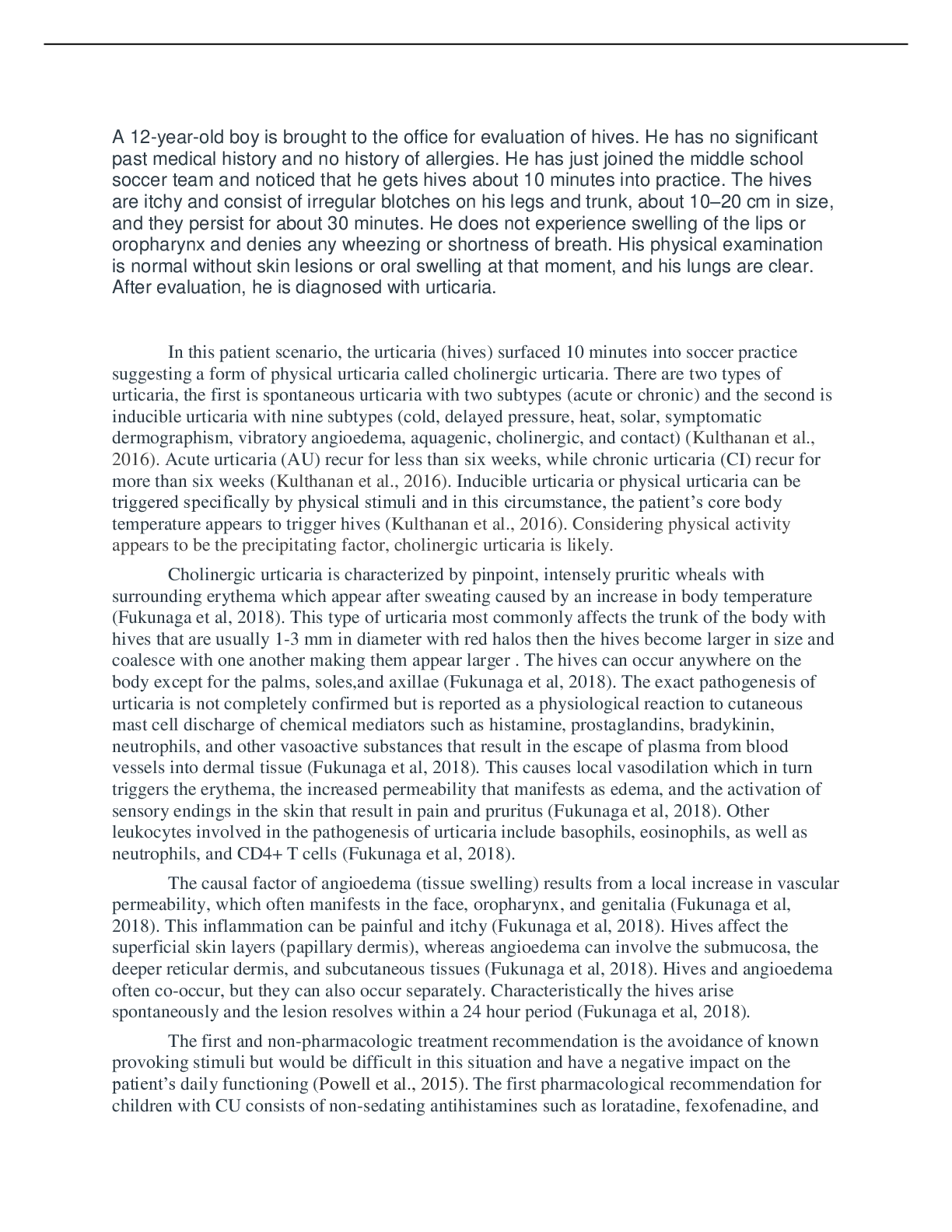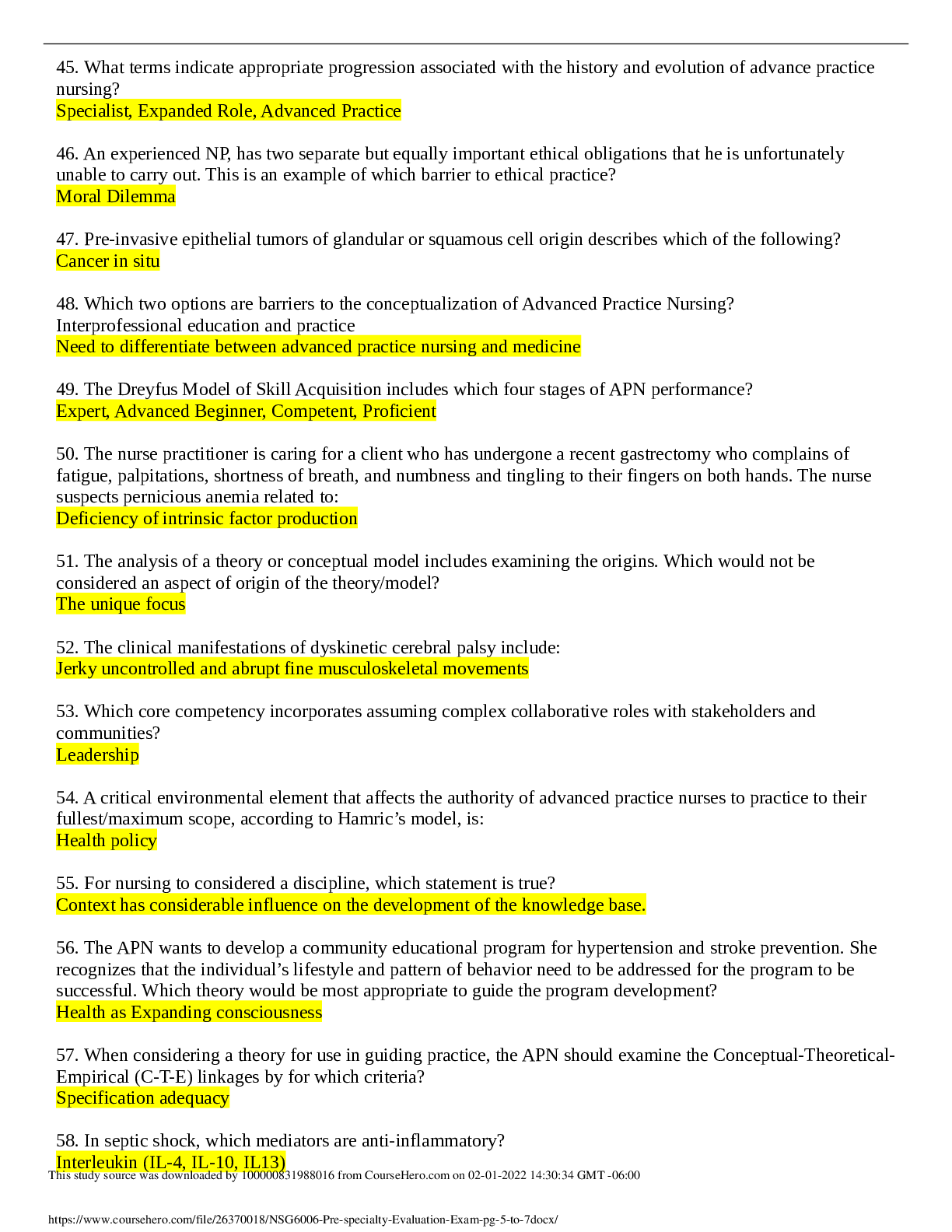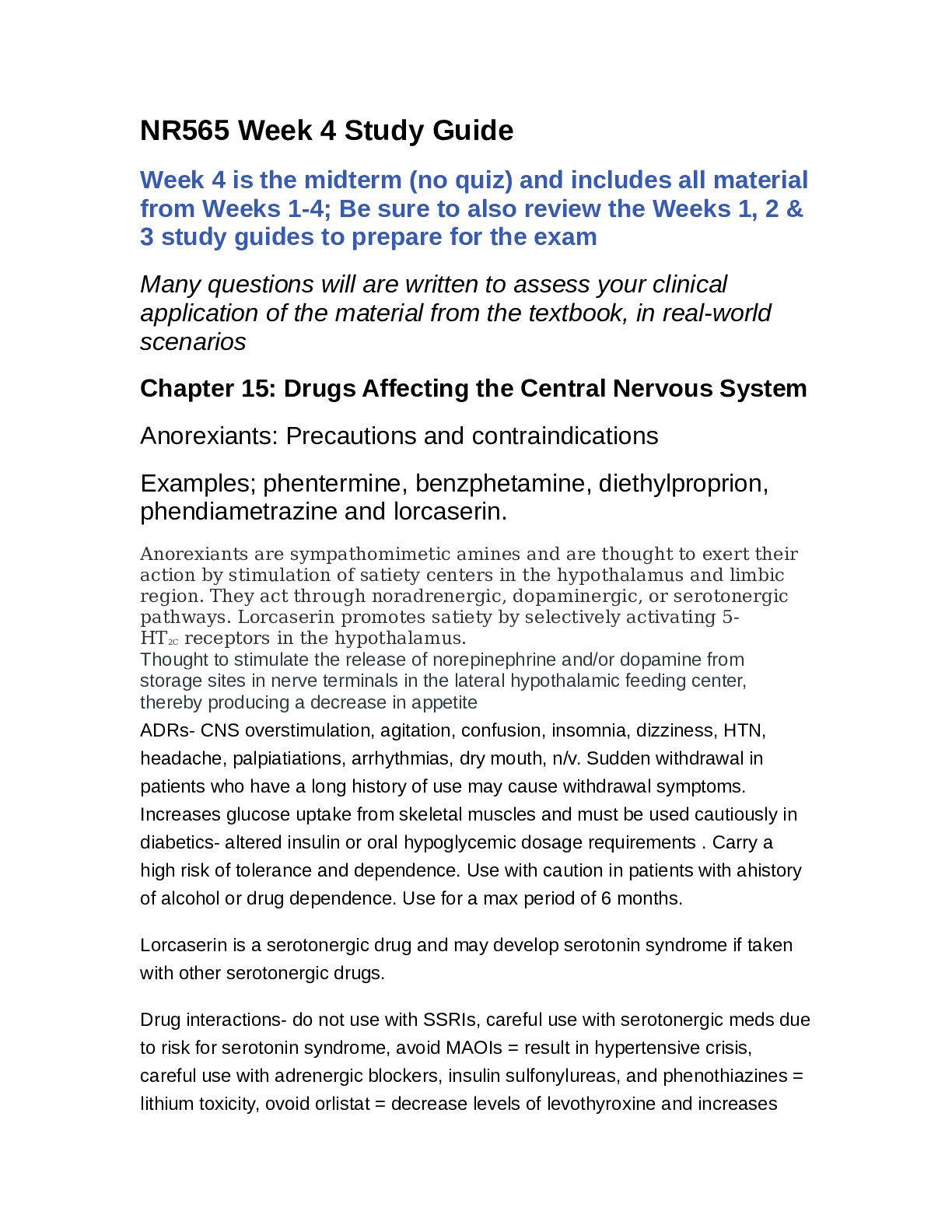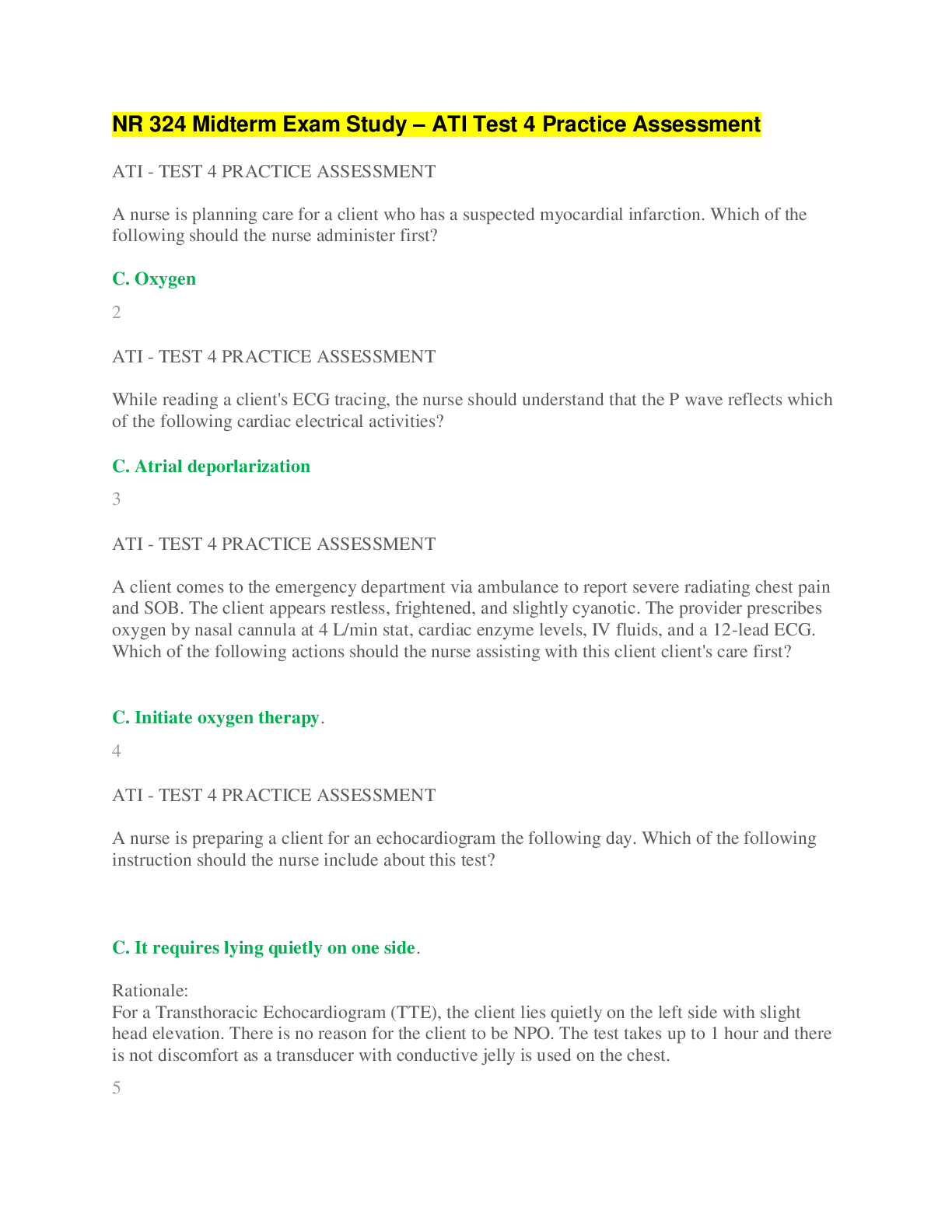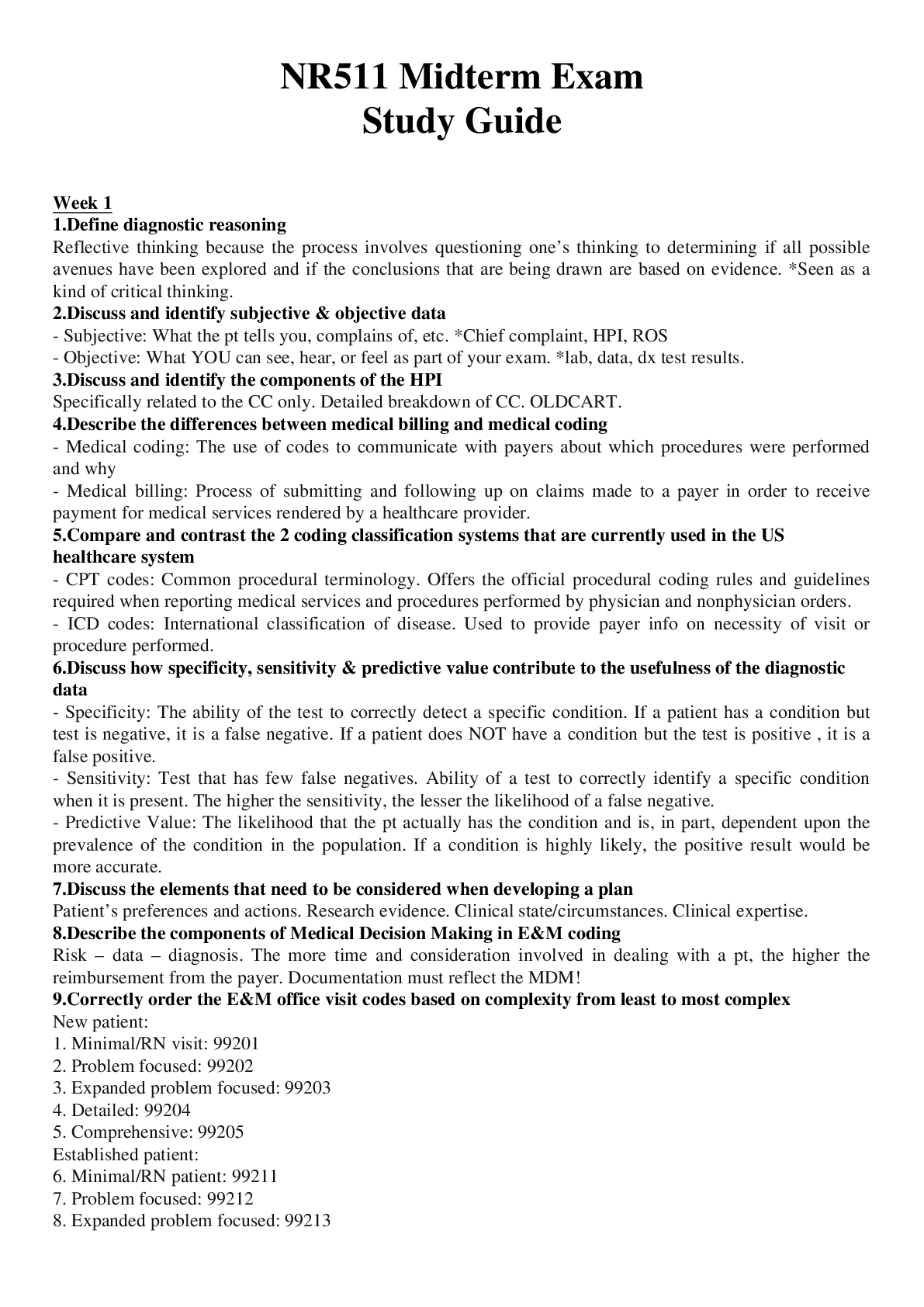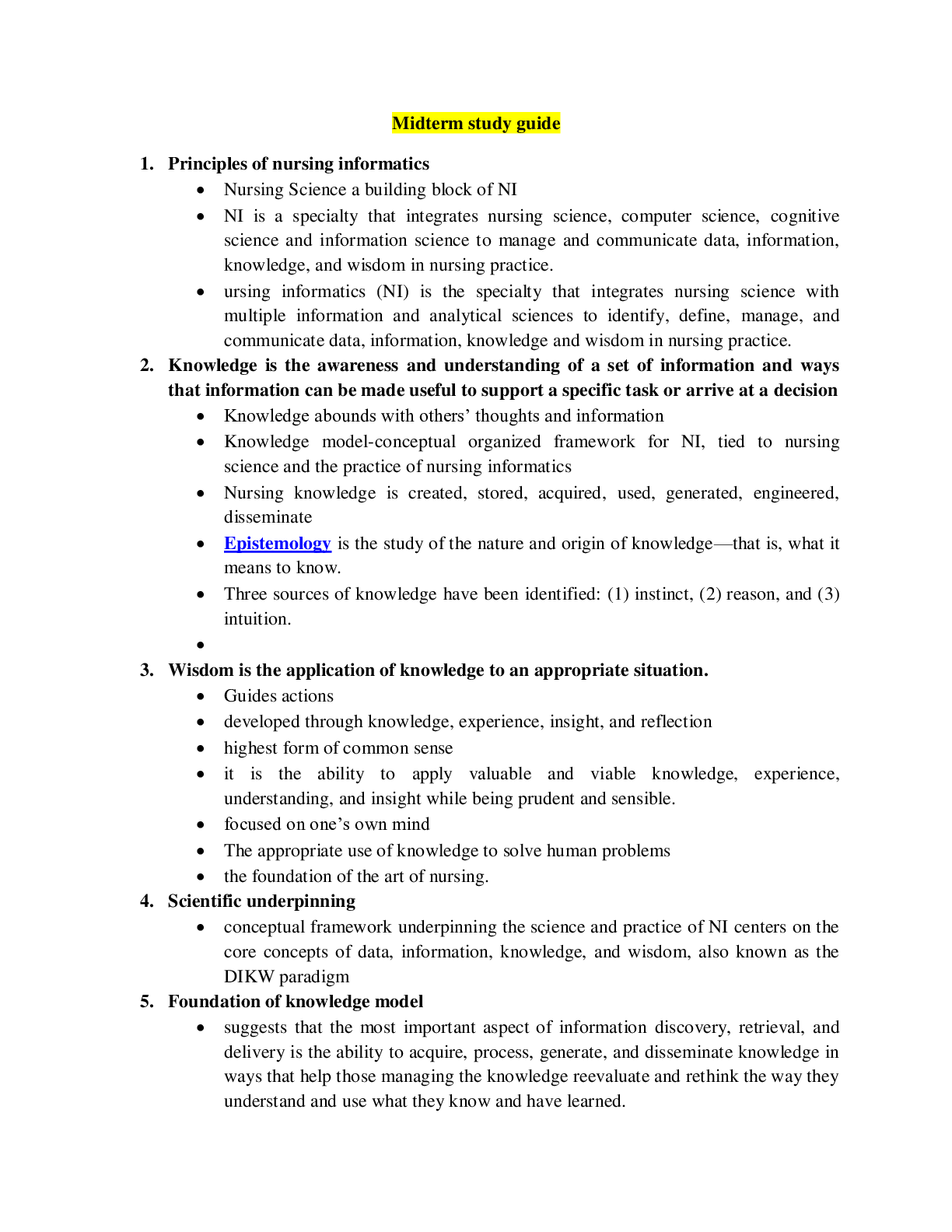*NURSING > STUDY GUIDE > NR 601 Midterm Exam Study Guide Weeks 1-4 content (All)
NR 601 Midterm Exam Study Guide Weeks 1-4 content
Document Content and Description Below
Weeks 1-4 content Week Topics 1 Developmental changes o Review Kennedy and Dunphy readings for age related changes o Physiological the major impact that occurs with physiological changes are – ... all of the above the strongest evidence regarding normal physiological ageing is availiable through longitudinal studies 5-5 Beginning at about age 55, most people can expect which of the following changes? A. A 1- to 2-in. decline in height B. Stable body weight C. Sharper vision and hearing D. Increased strength 5-31 Which of these musculoskeletal changes accompany older adulthood? A. Change in stature B. Increased stride length 5-35 Which one of the following is a normal physiological change of aging? A. A decrease in strength and speed of muscle contraction in the extremities B. Degenerative arthritis C. Rheumatoid arthritis D. Bulging intervertebral disks 5-37 Evaluating an older adult client according to the successful aging paradigm involves assessment of A. cognition, problem-solving, physical skills, and memory. B. health, social engagement, mental activity, and life satisfaction. C. vision, hearing, balance, and strength. D. coping, social support, fi nancial resources, and living arrangement. 5-49 The benefi ts of exercise during middle adulthood include which of the following? A. Less need for an increase in dietary calcium B. Slower decli ne in central nervous system processing 5-50 When completing the health history and review of systems for a healthy 88-year-old woman, you would expect which age-related change to be reported? A. Mildly blurry vision B. Chronically dry and itchy eyes and eyelids C. Increasing presbyopia 5-61 Which cognitive change is expected in healthy older adults aged 65 and older? A. Decrease in IQ B. Slower information processing C. Low capacity for learning D. Decreased attentional focus 5-57 Sleep in older adults is characterized by which pattern? A. Increased time spent in REM sleep B. Increased overall sleep time C. Increased sleep latency D. Increased proportion of deep sleep 5-67 Risks for automobile accidents are increased in older adult drivers due to which normal changes associated with aging? A. Decreased ability to understand driving-related dangers B. Lack of recognition of their own physical challenges C. Magnifi ed physiological response to stressful situations D. Increased reaction time 5-85 Older adults face greater risks for fl uid imbalance than young adults and middle adults due to which age-related factor? A. Increased amounts of intracellular fl uid and total body water B. Higher proportion of fat to muscle cells C. Faster speed of metabolism D. Increased intestinal motility 5-86 Which strategy for care of older adults is inconsistent with an approach supportive of aging in place? A. Make changes to the home environment that can accommodate an individual’s changing needs. B. Refer for home care and adult day-care services. C. Hire assistants to help with activities of daily living. D. Emphasize the individual’s limitations and likely need for long-term care placement. 5-96 Which theory of aging focuses on older adults’ development of specifi c strategies to manage losses of function over time? A. Disengagement theory B. Activity/developmental task theory C. Personenvironment fi t theory D. Selective optimization with compensation theory 5-107 Why is Alzheimer’s disease (AD) considered a specifi c disease, distinct from the normal . changes of aging? A. There are types of AD that are inherited and present before age 60. B. There are changes in biological processes that occur with normal aging. C. There is a notable decline in cognitive functioning as people age. D. There are multiple changes in organ functioning, especially in the brain. 5-115 Physiological changes of aging can affect functional mobility. Screening for functional mobility of older adults involves which screening tool? A. Katz Index B. Get Up and Go Test C. Functional Independence Measure D. Mini Mental State Exam 5-112 Your 66-year-old patient is able to correctly interpret the meaning of the proverb “A penny saved is a penny earned.” This helps to establish the patient’s expected ability to A. access long-term memory. B. engage in abstract reasoning. C. execute concrete operations. D. follow complex instructions. 13-68 In the older adult, which physiological change affects pharmacokinetics? A. Decreased creatinine clearance B. Increased lean muscle mass C. Decreased total body fat D. Increased serum albumin level 18-98 Physiological changes in the immune system of older adults include A. an increase in immunoglobulin A and G antibodies. B. a high rate of T-lymphocyte proliferation. C. an increase in the number of cytotoxic T cells. D. an increase in CD8, which affects regulation of the immune system. 61 The aging process results in a variety of physiological changes. One change is A. a decreased absorption of fat-soluble vitamins. B. an increase in pupil size. C. an increase of enzymatic activity. D. an increase in spleen size. A- the heart valve o Lab results- Dunphy Table 77.2 TABLE 77.2 Changes in Laboratory Values for Older Adults Laboratory Test Normal Values Changes With Age Comments URINALYSIS Protein 0–5 mg/100 mL Rises slightly May be due to kidney changes with age, urinary tract infection, renal pathology Specific gravity 1.005–1.020 Lower maximum in elderly 1.016–1.022 Decline in nephrons impairs ability to concentrate urine HEMATOLOGY Erythrocyte sedimentation rate Men: 0–20 Women: 0–30 Significant increase Neither sensitive nor specific in aged Iron binding 50–160 mcg/dL 230–410 mcg/dL Slight decrease Decrease Hemoglobin Men: 13–18 g/100 mL Men: 10–17 g/mL Anemia common in the elderly Women: 12–16 g/100 mL Women: none noted Hematocrit Men: 45%–52% Women: 37%–48% Slight decrease speculated Decline in hematopoiesis Leukocytes 4,300–10,800/mm3 Drop to 3,100– 9,000/mm3 Decrease may be due to drugs or sepsis and should not be attributed immediately to age Lymphocytes 500–2,400 T cells/mm3 50–200 B cells/mm3 T-cell and B-cell levels fall Infection risk higher; immunization encouraged Platelets 150,000–350,000/mm3 No change in number BLOOD CHEMISTRY Albumin 3.5–5.0/100 mL Decline Related to decrease in liver size and enzymes; protein-energy malnutrition common Globulin 2.3–3.5 g/100 mL Slight increase Total serum protein 6.0–8.4 g/100 mL No change Decreases may indicate malnutrition, infection, liver disease Blood urea nitrogen Men: 10–25 mg/100 mL Women: 8–20 mg/100 mL Increases significantly up to 69 mg/100 mL Decline in glomerular filtration rate; decreased cardiac output Creatinine 0.6–1.5 mg/100 mL Increases to 1.9 mg/100 mL seen Related to lean body mass decrease Creatinine clearance 104–124 mL/min Decreases 10%/decade after age 40 years Used for prescribing medications for drugs excreted by kidney Glucose tolerance 62–110 mg/dL after fasting; >120 mg/dL after 2 hours postprandial Slight increase of 10 mg/dL/decade after 30 years of age Diabetes increasingly prevalent; drugs may cause glucose intolerance Alkaline phosphatase 13–39 IU/L Increase by 8–10 IU/L Elevations >20% usually due to disease; elevations may be found with bone abnormalities, drugs (e.g., narcotics), and eating a fatty meal all of the following are true about lab results except : abnormal findings are usually due to physiological aging. o Atypical disease presentations 1. Acute abdomen Absence of symptoms or vague symptoms, acute confusion, mild discomfort and constipation, some tachypnea and possibly vague respiratory symptoms, appendicitis pain may begin in right lower quadrant and become diffuse 2. Depression Anorexia, vague abdominal complaints, new onset of constipation, insomnia hyperactivity, lack of sadness 3. Hyperthyroidism Hyperthyroidism presenting as “apathetic thyrotoxicosis,” i.e., fatigue and weakness; weight loss may result instead of weight gain; patients report palpitations, tachycardia, new onset of atrial fibrillation, and heart failure may occur with undiagnosed hyperthyroidism 4. Hypothyroidism Hypothyroidism often presents with confusion and agitation; new onset of anorexia, weight loss, and arthralgias may occur 5. Malignancy New or worsening back pain secondary to metastases from slow growing breast masses Silent masses of the bowel 6. Myocardial Absence of chest pain infarction (MI), vague symptoms of fatigue, nausea, and a decrease in functional and cognitive status; classic presentations: dyspnea, epigastric discomfort, weakness, vomiting; history of previous cardiac failure, higher prevalence in females versus males Non-Qwave MI 7. Overall infectious diseases process Absence of fever or low-grade fever, malaise 8. Sepsis Without usual leukocytosis and fever, falls, anorexia, new onset of confusion and/or alteration in change in mental status, decrease in usual functional status 9. Peptic ulcer disease Absence of abdominal pain, dyspepsia, early satiety, painless, bloodless, new onset of confusion, unexplained, tachycardia, and/or hypotension 10. Pneumonia Absence of fever; mild coughing without copious sputum, especially in dehydrated patients; tachycardia and tachypnea; anorexia and malaise are common; alteration in cognition. 11. Pulmonary edema Lack of paroxysmal nocturnal dyspnea or coughing; insidious onset with changes in function, food or fluid intake, or confusion 12. Tuberculosis (TB) Atypical signs of TB in older adults include hepatosplenomegaly, abnormalities in liver function tests, and anemia 13. Urinary tract infection Absence of fever, worsening mental or functional status, dizziness, anorexia, fatigue, weakness 17-11 An elderly client with hyperthyroidism may present with atypical symptoms. Which of the following manifestations are commonly seen in the elderly with hyperthyroidism? A. Adrenergic fi ndings such as tachycardia B. Weight gain, depression, and heat intolerance C. Atrial fi brillation, depression, and weight loss D. Heat intolerance, hyperrefl exia, and anorexia atypical disease presentation in the elderly is reflected by all except: myocardial infarction wi [Show More]
Last updated: 1 year ago
Preview 1 out of 37 pages
Instant download
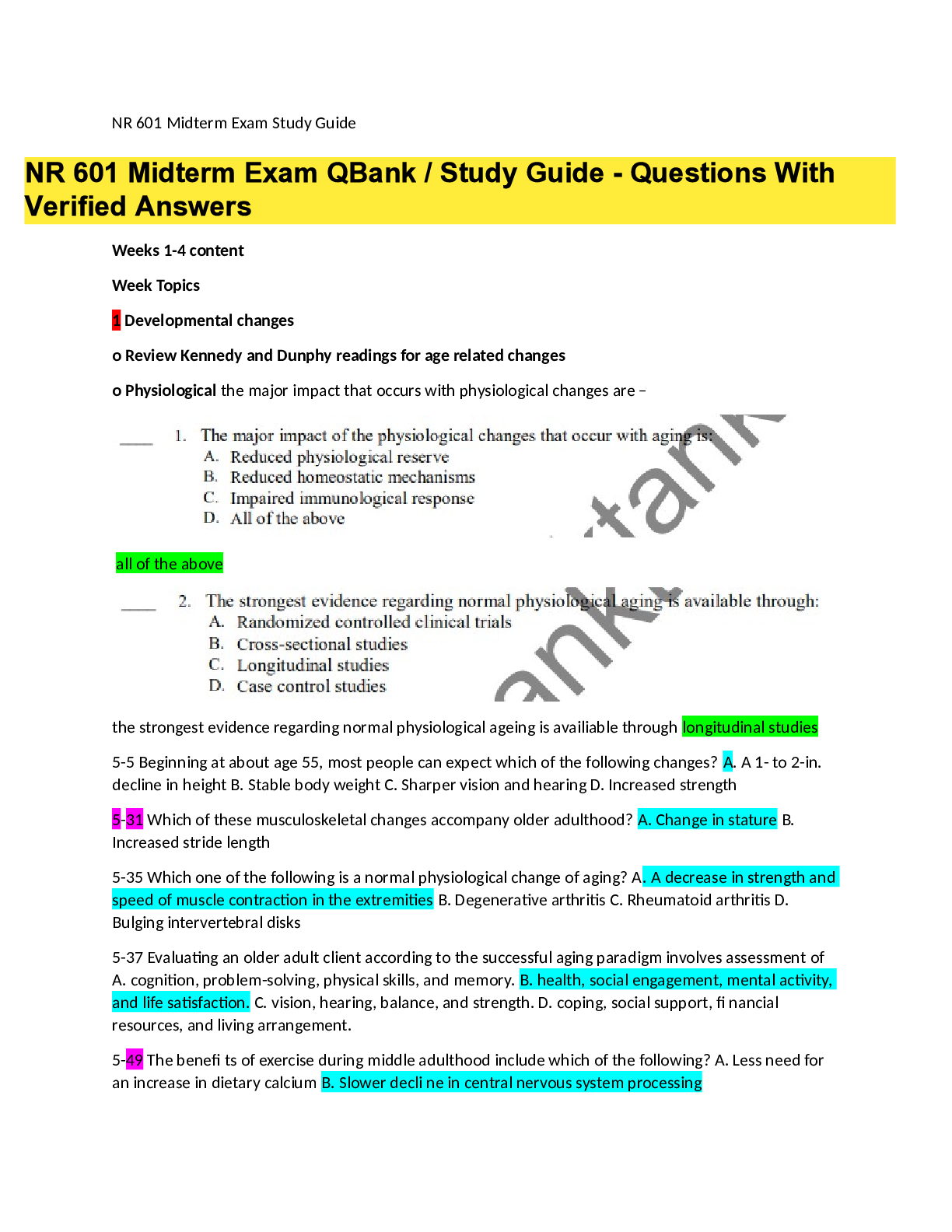
Buy this document to get the full access instantly
Instant Download Access after purchase
Add to cartInstant download
Reviews( 0 )
Document information
Connected school, study & course
About the document
Uploaded On
Nov 05, 2021
Number of pages
37
Written in
Additional information
This document has been written for:
Uploaded
Nov 05, 2021
Downloads
1
Views
106



